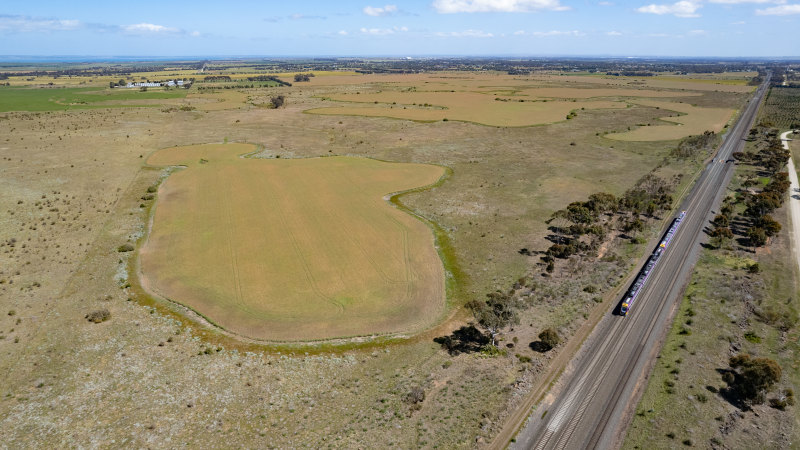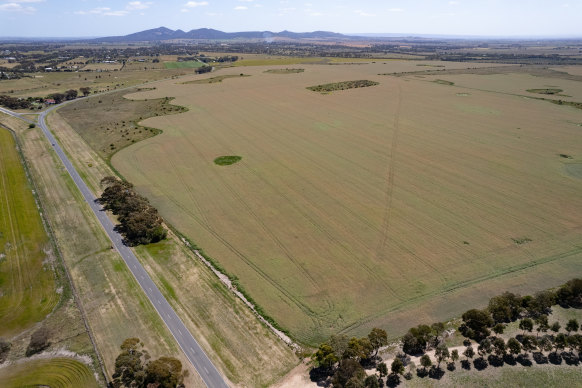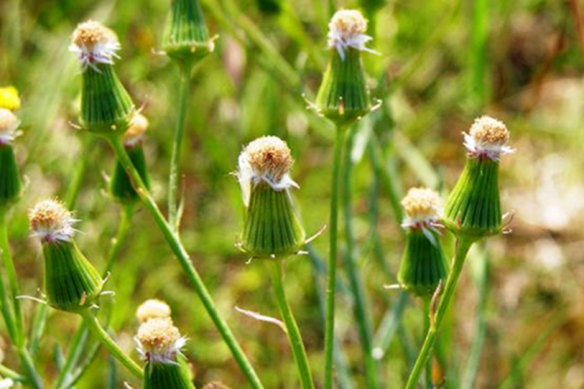This paddock on Melbourne’s fringe could be home to 2 million shipping containers

Save articles for later
Add articles to your saved list and come back to them any time.
Australia’s largest private rail freight company plans to build a huge rail terminal and warehousing hub on green wedge land west of Werribee, promising to create 3600 new jobs and remove thousands of trucks a year from the roads.
But the proposed project, which will cost Pacific National between $3 billion and $5 billion to build, could also exact a toll on Victoria’s environmentally sensitive western grasslands, which are home to several critically endangered animals and plants.
Pacific National’s proposed Little River rail freight terminal would claim 595 hectares of farmland and native grassland west of Melbourne. Credit: Jason South
The terminal would also transform life in the township of Little River, between Melbourne and Geelong, bringing to its doorstep a sprawling rail freight facility operating 24 hours a day and handling a forecast 2 million or more shipping containers a year.
Pacific National says it needs to open a new rail terminal by 2029, as the lease on its current base at Dynon Road, West Melbourne, will expire by 2031.
The inner-city rail network is also incapable of supporting 1800-metre-long trains carrying double-stacked shipping containers, which will run on the federal government’s 1700-kilometre Inland Rail freight route between Melbourne and Brisbane.
The Little River terminal would occupy 595 hectares of what is currently a mix of farmland and native grassland on the edge of Melbourne’s urban boundary, and would neighbour the new Cherry Creek youth detention centre.
The site includes habitat for critically endangered plants and animals. The company will need to gain state and federal approval for the major project.
Detailed plans submitted to Victoria’s Department of Transport and Planning say it would include a new 205-hectare “biodiversity zone”, which the company says it would rehabilitate to its original native state.
Pacific National chief executive Paul Scurrah said building new rail freight terminals was fundamental to shifting large volumes of freight from trucks to trains.
“The result is less traffic congestion, reduced truck emissions, fewer road accidents and fatalities, and less wear and tear on local and state roads,” he said.
If the terminal is not built, the company claims an extra 250,000 truck trips a year will happen on Melbourne’s roads by 2031, and that an additional 400,000 tonnes of CO2 will be emitted by 2051 due to those extra truck trips.
The company says the site will be a major economic boon for Victoria, generating an estimated $20 billion in gross state product between 2024 and 2050 and an additional 3600 full-time equivalent jobs in the Little River region.
But nearby residents fear the terminal will ruin their rural way of life, while one environmental expert said Victoria’s unique grasslands west of Melbourne were being pushed closer to extinction with each new development project.
The terminal will operate 24 hours a day, seven days a week, with freight trains and large heavy vehicles accessing the site, which will also have cranes continually loading and unloading containers.
“It would just destroy the township, a freight terminal there,” said Brian Jobling, a long-time Little River resident.
The large facility, operating just 1½ kilometres from the township, would generate increased traffic, noise and light, the plans show.
Jobling said he feared light pollution and industrial noise from the facility would be never-ending.
Part of the land it would be built on is zoned green wedge. It contains an area of Aboriginal cultural heritage sensitivity, and habitat for critically endangered species including the striped legless lizard and golden sun moth, the proposal states.
Some threatened habitat would need to be cleared, including up to 300 critically endangered large-headed fireweed plants.
Up to 300 critically endangered large-headed fireweeds will be destroyed if the rail terminal is built.
The biodiversity zone would partially offset these losses.
Sarah Bekessy, professor in sustainability and urban planning at RMIT University, said the grasslands to Melbourne’s west were at real risk of being driven to extinction due to housing and industrial developments in the area.
“It’s always the case that it is public land or these green wedges that are targets, and we have to get away from that kind of thinking and see them as the assets to our city that they are,” Bekessy said.
“It’s Australia’s most endangered ecosystem. It’s pretty much on the brink of going extinct and is absolutely full of threatened species.”
Wyndham councillor Josh Gilligan said a planned freight terminal in the outer western suburb of Truganina had previously been identified as a priority location, but had been held up by state and Commonwealth failure to work with the private sector.
“This 350-hectare intensive industrial development must be subject to an environmental effects statement review given its proximity to the You Yangs, our grasslands and our rural community of Little River,” Gilligan said.
Some forms of development, including transport terminals, are permitted within Melbourne’s green wedge zones.
Pacific National commissioned polling company RedBridge to gauge community sentiment about the proposed terminal, surveying more than 1300 residents of the south-western suburbs and Geelong in May.
Given a choice, respondents favoured a privately funded rail freight terminal in Little River over a government-funded one in Truganina, by 65 per cent to 35 per cent.
Little River’s relative isolation was a key factor because it would mean fewer truck trips in established suburbs, and less potential for conflict between industry and residents, the surveys found.
The Age contacted the Department of Transport and Planning but did not receive a response by deadline.
Get the day’s breaking news, entertainment ideas and a long read to enjoy. Sign up to receive our Evening Edition newsletter here.
Most Viewed in National
From our partners
Source: Read Full Article

